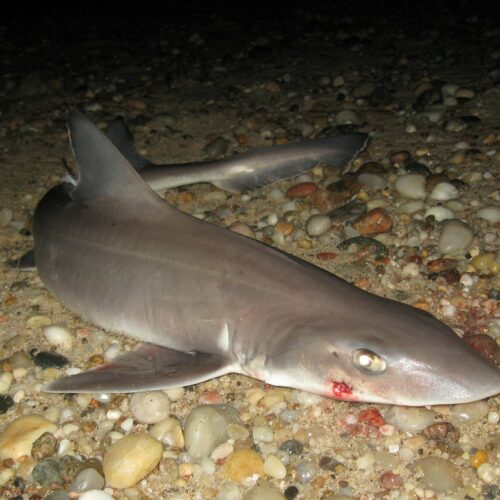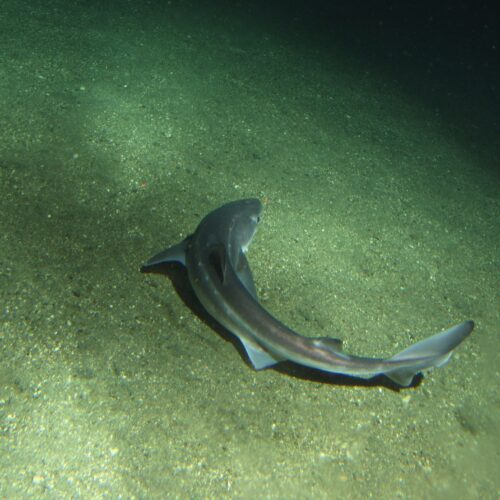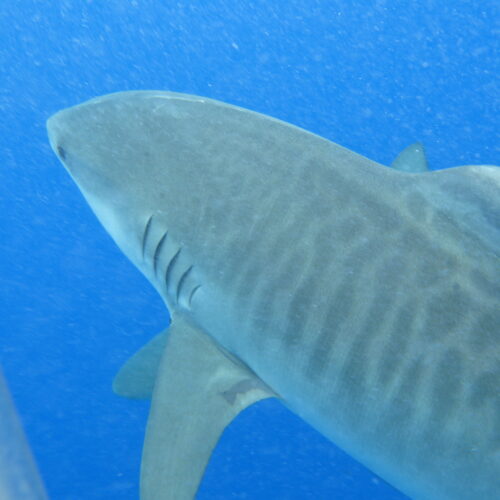Being the group that includes the largest fish in the world (the whale shark), sharks are generally large, cartilaginous fish that are found in all of the world’s seas and are very commonly found in waters up to around 2000 meters or so.
While surprising in some respects, the presence of sharks should really be expected in Delaware (though not in overly large numbers). This is due to the numerous beaches that Delaware possesses, being one of the states on the Atlantic coast. As sharks live in most of the world’s seas, it’s only natural that they can end up in coastal areas.
Here are some of the more common species encountered:
Sandbar Shark
Arguably the most common shark you’ll encounter in the waters around Delaware, it is commonly mistaken for the bull shark.
Here are some of its characteristics (Source):
- The upper side is bluish to brownish gray with the underside a lighter shade of the same color to white.
- The first pectoral fins are large and broad. The dorsal fins are differently shaped.
- They have a defined interdorsal ridge (ridge of skin going down the back between the two dorsal fins).
- The upper teeth are broadly triangular and serrated. The lower teeth are narrower and more finely serrated.
So, are sandbar sharks a danger to humans? For this species, they’re… not classified as such. Well, not really. Despite their large size, they normally don’t attack humans nor are they aggressive toward us. One documented incident where a girl was bitten in Ocean City by a sandbar appeared to happen because she was in the way of the shark feeding, rather than the shark going after her directly. You can read more about that here.
As expected of most sharks, you’ll can expect to encounter Sandbar sharks along the east coast, but more frequently in Delaware Bay in particular, as it’s a key nursing ground for juveniles.
Sand Tiger Shark
A large, bulky shark with a flattened snout.
Here are some of their characteristics (Source):
- The upper side is light brown or light greenish-gray with the underside a grayish white. Many individuals have darker reddish or brown spots scattered on the body.
- The first dorsal fin is far back on the body, behind the first pectoral fin.
- The first and second dorsal and anal fins are nearly equal in size.
- Their teeth are dagger-like and protrude from mouth. Their ragged looking teeth give the Sand Tiger Shark a distinct menacing look.
Found in the ocean but also in Delaware Bay as well as the Inland Bays, sand tigers are large, fearsome-looking sharks, with their mouths lined with outward-pointing teeth. However, this is deceptive.
Just like the sandbar shark, sand tiger sharks may look dangerous, but they are docile and generally not a danger to humans, either. They’re loners, so if you happen to come across one, it’s unlikely that they have any others with them.
Smooth Dogfish Shark
Slender with a tapering, blunt snout.
Here are some of their characteristics (Source):
- The upper sides vary from gray to brown with the underside a yellowish gray to white.
- Their eyes are large, oval-shaped and catlike.
- They have two large spineless dorsal fins with the first dorsal fin slightly larger than the second. The upper lobe of tail has a deep notch near the tip.
- Their teeth are pavement-like and non-cutting.
Unlike the previous two entries which look dangerous, the Smooth Dogfish is anything but that. For one thing, it’s far smaller than the other two mentioned so far. Usually around two to three feet, they’re among the smaller sharks but are very common around the Delaware coasts. Even in the extremely unlikely event that one would try to bite you, its teeth are too blunt to do any real damage.
They seem to love Delaware Bay, as many gather there, especially in the warmer months. If you’re looking to catch a glimpse of this particular species, that’s the place to be.
Spiny Dogfish Shark
Gray to brown on top with white spots and pale gray to white below.
Here are some of their characteristics (Source):
- Their pupils are an iridescent blue-green.
- They have a single spine in front of each of their two dorsal fins.
- Spiny Dogfish do not have an anal fin.
- Their teeth are pavement-like, but with an extra set of small, very strong and very sharp teeth (often difficult to see).
Almost identical to previous entry, the Spiny Dogfish looks very much like it. While they have sharper teeth compared to the Smooth Dogfish, they’re no danger to humans, either. Their small size would make it hard for them to do any real damage. Not that they would try – they’re non-aggressive.
As they’re found all over the North Atlantic, it’s no surprise that they show up in the waters around the First State, as well. Their relative abundance mean they can be seen quite commonly around Delaware Bay, and they sometimes end up being caught by anglers.
Tiger Shark
Very different from the other entries so far, the tiger shark is nevertheless fascinating (in a dangerous way).
Here are some of their characteristics (Source):
- The Tiger Shark gets its name from dark black spots and vertical bars (stripes) which run the length of the body.
- They are a bluish-green to dark gray or black on top with yellowish-white to white underneath.
Ok, so here’s the first shark that you’ll generally want to avoid. While shark attacks against humans are relatively rare, unlike the first four, the tiger shark is dangerous, as it’s an aggressive species (yes, even against humans).
Not only are they large, they like going into shallow waters, which becomes problematic as those are usually where people like to be when they go swimming near the coast.
Be very careful when bathing in Delaware Bay or anywhere along the Atlantic coast, really. While they’re not very common compared to other sharks, this is one you definitely don’t want to meet at the beach.
Hammerhead Shark
They look unusual, that’s for sure, but no matter what you make of their shape, there’s no mistaking it; hammerheads are among the most dangerous species of sharks.
Here are some of their characteristics (Source):
- The top of the Great Hammerhead Shark is dark brown to light gray or even olive in color fading to white on the underside.
- Its hammer-shaped head is relatively straight across the front.
Very distinct for their heads’ shape, hammerheads are both fascinating and terrifying to see. Just like the tiger shark, here’s another species you’ll want to watch from afar. Not only are hammerheads large, they are also aggressive and have been known to attack humans, though they appear to prefer fish and crustacians.
Again, like the tiger shark, they like to tend to shallow water, even if they’re not as abundant as the others on this list. Their head’s strange shape is used to sweep for prey in the sand, making them especially dangerous for people who happen to be in the water at the same time.
They’re found up and down along the Atlantic coast, and as Delaware is one of those states that borders this part of the ocean, be careful when bathing.
While these are among the shark species you can expect to encounter along the Delaware coasts, they certainly aren’t the only ones. You can check out the list of sharks and other marine animals here.
Sharks are amazing, fascinating, animals, despite how some of them look at behave. While some species are harmless, others can quite literally bite your limb off, so you’ll want to be extra careful around those. As a last note, here are some things you’ll want to avoid doing in their presence:
- Always swim in a group
- Don’t stray too far from shore
- Swim in water where you can see your feet
- Avoid the water at dawn, dusk and at night
- Don’t enter the water if you’re bleeding
- Avoid waters being fished, bait and schools of fish
- Don’t wear shiny objects in the water































